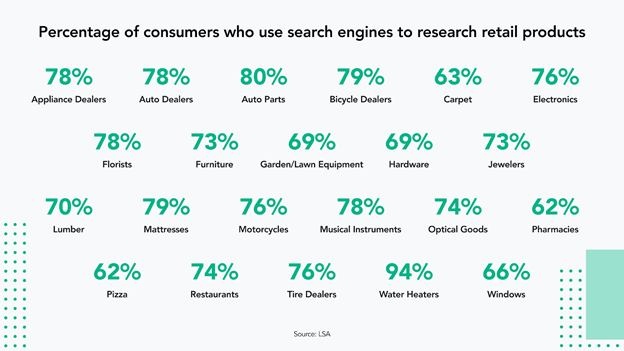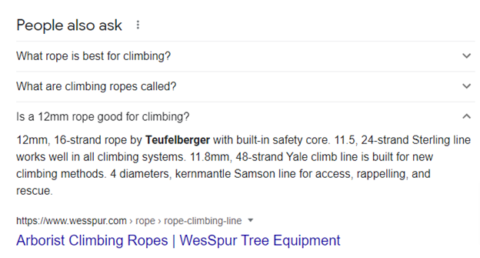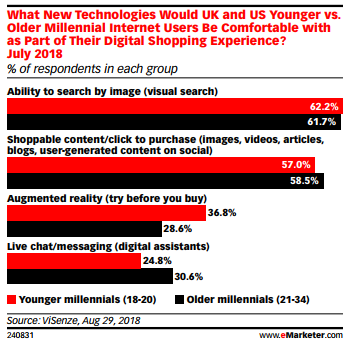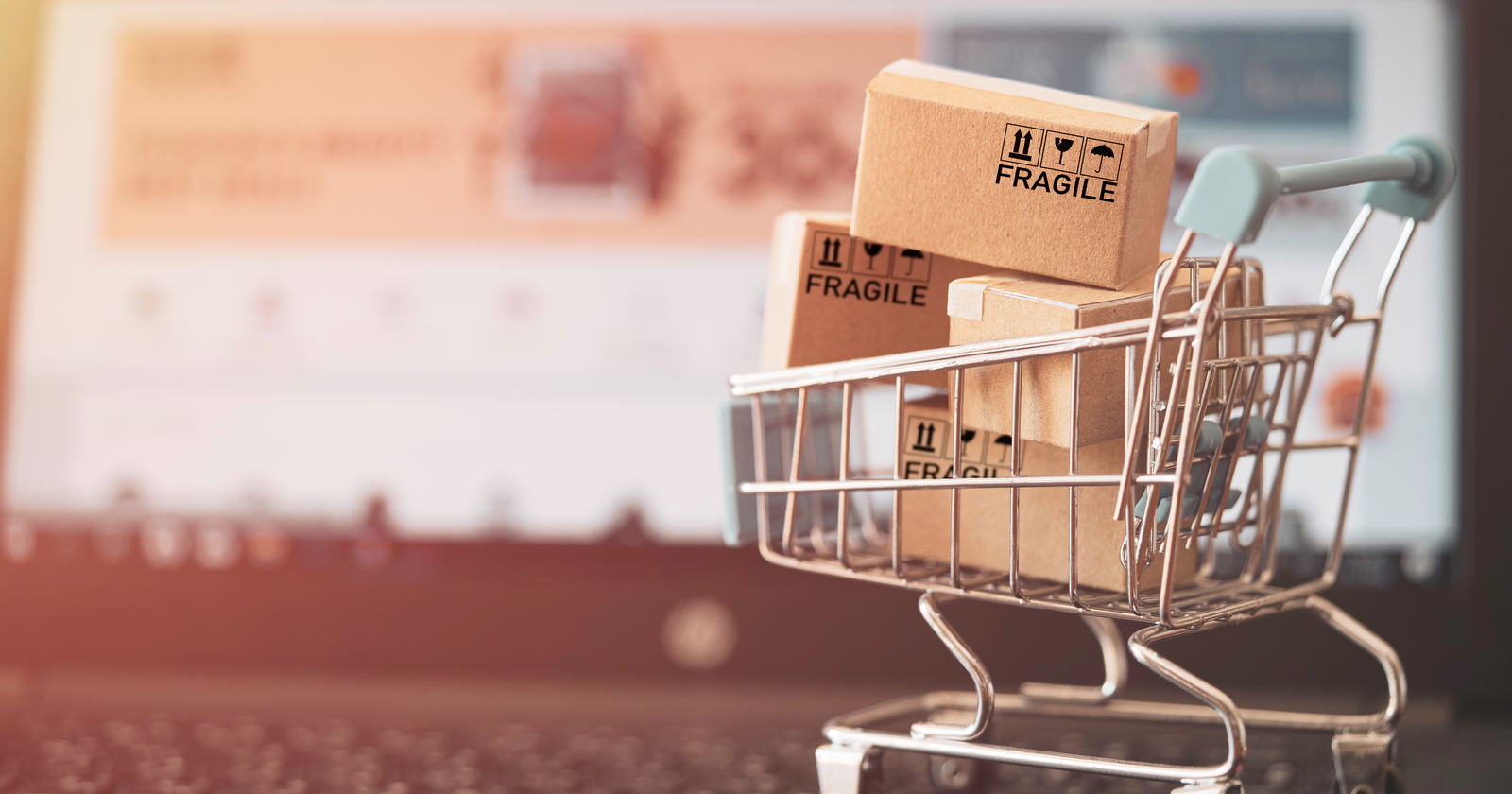Ecommerce is expected to reach almost 35% of sales among big-box retailers worldwide by 2023, rising from 23% in 2019, according to Edge Retail Insight.
This growth is expected to continue, with ecommerce taking a nearly 40% share of sales by 2025.
This comes amid strong online growth and stable or declining physical store sales worldwide.
However, store-based retail nevertheless continues to account for the majority of sales. Additional research shows consumers prefer a mix of online and offline shopping.
Regardless of how the transaction is carried out, the majority of shoppers use search engines for discovery and comparison shopping.
 Image from LSA, February 2022
Image from LSA, February 2022That means that whether customers are shopping in your store, on your website, or via a social commerce platform, SEO is an area of opportunity retailers cannot afford to miss.
Here are 10 top priorities for your retail SEO strategy.
1. Keyword Research
Keyword research is extremely important for retail brands. Knowing what keywords consumers are searching for and how they are searching is vital to building out your informational architecture and content strategy.
It should cover keywords at all stages of the fragmented user journey:
- informational,
- navigational,
- transactional,
- and intent-based.
There are a plethora of keyword research tools, but always make sure to review your competitors’ keyword research strategy, too.
That includes Amazon because of the high purchase intent there. Use Amazon’s keyword tool, as well as tools like Ahrefs.
Once the site is up and running, review paid search data and find keywords that are converting and driving traffic and sales.
Make sure the site is ranking on the first page wherever possible of all the major search engines for those keywords through ongoing optimization.
This will help you augment organic performance initially but then reallocate your paid budget over time as SEO proves its value.
2. Local Search
Getting found online is key to driving traffic and sales.
It’s a simple truth that the more you show up for your customers, the more your business thrives and can provide services.
But when it comes to local search, accuracy matters.
So get on a good local search platform and then claim and optimize your listings.
Optimized listings help your retail brand show up at the top of local searches and provide a consistent customer experience to drive acquisition and retention.
Make sure you are taking advantage of Google Business Profiles, a tool that helps businesses manage their presence across Google properties, to share updates with your customers.
Add photos to your GBP listings to improve the customer experience, add attributes so customers know what to expect, display your products and inventory, submit relevant categories, respond to Q&A, and also monitor and respond to reviews.
I can’t tell you how many retail brands still don’t respond to reviews, both good and bad.
To learn more about how to optimize for local search, read the Definitive Guide to Improve Your Local Search Rankings.
3. Structured Data
Structured data can help search engines better understand your content and improve visibility via Featured Snippets.
For retail brands, the most important structured data type is product schema.
All your products should be marked up with product schema so Google and other search engines can publish more information about your products and get a better understanding of what your brand sells.
Other important structured data types for retail stores and local businesses are local business schema, which posts your address, ratings and reviews, website, geocoordinates, events, etc.
To learn more, visit How to Use Schema for Local Search.
4. Top Quality Content
Fresh, high-quality content based on intent is very important for retail brands.
That’s in part because 81% of retail shoppers conduct online research before buying.
With so many users doing online research – and over 70% of this research coming from mobile phones – it’s imperative you have content that satisfies their needs.
If I was working with a new retail brand, I would make sure my category pages and product pages are filled with high-quality and unique content.
Additionally, I would make sure I have a blog that helps users solve problems and offers advice, tips, and how-to content that is relevant to the brand.
It’s important to optimize product review pages, as well.
I still come across big retailers that do not have any content blocks or FAQ content on their category pages and limited content on their product pages, which is a missed opportunity to rank for upper funnel and transactional keywords.
For example, on the climbing ropes category page for outdoor retailer REI, there is no content block that describes what a climbing rope is or answers any questions for the Google rich snippet feature, People Also Ask (PAA).
Instead, other sites are dominating the featured snippets for content that REI should own.
 Image from REI, January 2022
Image from REI, January 2022 Screenshot from search for [climbing ropes], Google, February 2022
Screenshot from search for [climbing ropes], Google, February 20225. Optimized Images
Humans are very visual. When it comes to retail, you can’t forget about optimizing images for both product and non-product-related keywords.
Shoppers like to see what it is they’re considering purchasing from multiple angles, close up, and even virtually placed in their own environment.
 Image by eMarketer, February 2022
Image by eMarketer, February 2022Always make sure to optimize your image file names, image size, formats, and alt text to help search engines understand your images and show up in the image search results for relevant keywords.
In addition, platforms like Pinterest and Instagram rely on images and are constantly honing their shopping features, so brands should optimize their images and video assets for those powerhouse discovery channels, as well.
6. Mobile and Core Web Vitals (CWV)
Mobile now accounts for more than half of all ecommerce traffic and definitely has taken over desktop as a top traffic-driving source.
Since shoppers are searching and buying products using their mobile devices, brands need to ensure their sites are optimized for mobile.
To do so, make sure the site is using easy-to-read text, is user-friendly, and has clear calls to action.
That helps ensure users interact with the main conversion points, i.e., buy products, sign up for rewards, etc.
In 2021, Google updated its algorithm to incorporate page experience as a ranking signal.
You also want to make sure your pages load as quickly as possible – preferably under three seconds – and are optimized for Core Web Vitals. This can give your page a boost and that could make the difference in super competitive retail SERPs.
According to a study from cybersecurity firm Radware, 51% of online shoppers in the U.S. claimed if a site was too slow they would not complete a purchase.
7. Backlinks
Backlinks are still an important part of any SEO strategy.
Always monitor your backlink profile to see if you have any links from spammy sites or broken backlinks and make sure your links have a mixture of branded and non-branded anchor text.
Also, remember having too many exact match anchor text links can be harmful to your link profile.
In order to obtain high-quality links, always make sure you have content that is helpful to end-users and satisfies their problems.
For example, one retailer that does this effectively is The Body Shop.
Since The Body Shop sells foundation, they have a post on How to Apply Foundation.
That attracts links to their site because it helps consumers solve a real problem. It’s educational and people would consider that a helpful share as opposed to an advertisement.
Coupon link building is a great option for retailers, as well.
8. SEO-Friendly Page Templates
When it comes to building page templates for retail brands, it’s important to follow SEO best practices.
Building and designing templates in an SEO-friendly manner ensures search engines can crawl and index your content.
Keep the following in mind as you optimize.
Document Templates
- Use front-loaded exact-match primary keywords and secondary keywords in your title tags. Be sure to use no more than 65 characters (including spaces).
- Utilize the SERP Preview Tool to see how the title will appear in the SERP and check for truncation.
- Maintain uniform branding with a pipe or dash.
- Provide search engines and searchers with a concise yet captivating description of what the page is about in the meta description.
- Maintain consistency with brand voice, messaging, and tone.
- Keep character counts to around 156 to 165 maximum, including spaces. You can utilize SERP Preview Tool to see how the description will appear in the SERP and check for truncation. Always include a Call to Action, like “Learn more”, “Find out how…”, “Browse [offerings]…”, etc. Avoid sounding like an advertisement or too promotional.
- Use one H1 tag per page with the primary keyword front-loaded. Your H1 should introduce the main topic/theme/title of the page and help provide structure and context.
- Use keyword-rich H2 tags (there is no limit on the number of H2s per page). Exact-matching longtail keywords/questions/voice search queries in the H2s helps target paragraph-type featured snippets in the SERP.
Body Copy Requirements
- Build out long-form content, containing at least 901-1200 words per page. Include exact matching for target keywords and internal linking to relevant PDPs/category pages as much as possible.
- Include CTA buttons, high-quality, compressed, optimized images with alt tags to improve UX and all text on images should be crawlable/indexable.
- Internal linking should include relevant PDPs/category pages as much as possible and include CTA buttons.
- The topic of page and body content should align with and serve both informational and commercial search intent (i.e., provide knowledge/article-type content while also making relevant products and shopping easily accessible).
- Internal linking to specific products should be strategically placed to increase the likelihood of conversion and keep the user on the site for as long as possible.
- Avoid transactional/promotional verbiage/obvious persuasion to gain sales.
URL Requirements
- URLs are a minor ranking factor and should be keyword-rich, semantically accurate, and succinct, providing a clear idea of what the page is about.
- Remove stop words and keep them as short as possible to make URLs look cleaner.
- Ensure the CMS will create URLs that are all lower case and structured properly.
9. Strong Technical Architecture And Foundation
Perform crawls of your site using Screaming Frog, Botify, DeepCrawl, or whatever crawler you prefer to make sure the site does not have any major technical issues that can harm your search engine rankings.
Always check for things like:
- Broken links on your site.
- Missing alt text or metadata.
- Thin and duplicate content.
- Your domain is accessible using non-www or www and there is only one version of your site. Other versions should be 301 redirected to the preferred version.
- Missing HTTPS.
- That the site does not have a no index and/or is not blocking pages that should be crawled.
- Google Analytics and Search Console are set up and verified.
- All your pages have unique and optimized metadata.
- Your site has minimal crawl errors, i.e., 404 pages, etc.
10. Measurement
Monitoring your SEO progress is extremely important for measuring how your retail brand is performing over time.
When launching a new brand, you want to make sure you’re ranking for all your brand-related keywords and in the top 30 for non-branded keywords.
As the site starts to age, continue to optimize to make sure you are ranking for high-volume and relevant keywords that are going to drive business value and ROI.
This may take a while for a new site, but it should take less time for an existing site, depending upon the state of the site and how competitive your aspect of retail is.
In addition, always monitor important KPIs, which can consist of but are not limited to the following:
- Branded rankings.
- Non-branded rankings.
- Golden keyword list, i.e., keywords that you have to own.
- Time on site.
- Bounce rate.
- Conversions.
- Organic visits.
- New organic visitors.
Other items to keep a careful watch on include paid search data, which can help build out your content and keyword strategy.
Also, prioritize keywords that perform well on the paid side to maximize efficiencies.
It’s also important to monitor Google Search Console for any manual actions, crawl errors, indexing issues, etc., and to address those issues right away.
Wrapping Up
Optimizing a retail website can help build your customer base and build trust among an audience looking specifically for the products you sell.
With the growth of ecommerce accounting for a good and growing portion of sales, focus on:
- Building and maintaining an SEO-friendly website that loads quickly.
- Creating content that satisfies the needs of end-users, helps users solve problems and attract links, is marked up with structured data, and is optimized for local search.
This will drive incremental revenue, traffic, and sales and take valuable search engine real estate away from your retail competitors.
More resources:
Featured Image: Dilok Klaisataporn/Shutterstock
